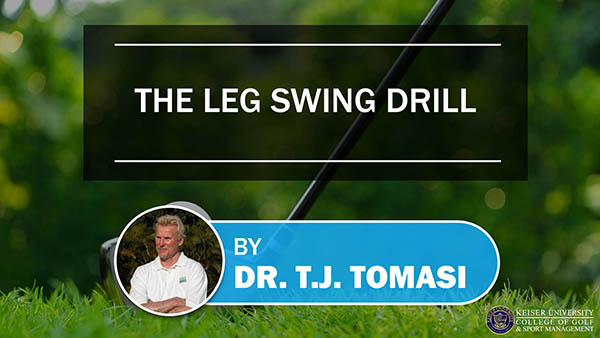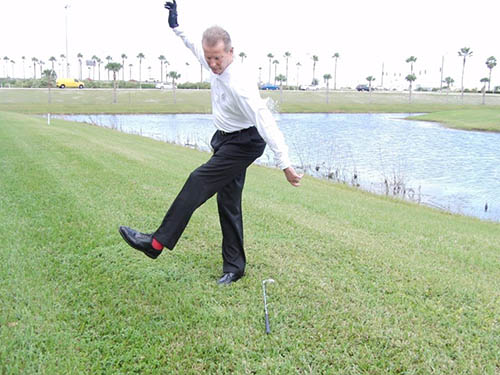The Leg Swing Drill

By Dr. T. J. Tomasi, Keiser University College of Golf Senior Faculty and Director of Research
When he was having swing problems a few years ago, Golf Magazine asked me what I would do if I were Phil Mickelson’s coach. My response was:
“Under pressure and/or when he tries to hit the ball too hard, Phil does not allow his back thigh to release completely to the target. As a result, the hands/arms hit over his back leg through impact —’Fore Right’— so he holds his release, and then it’s ‘Fore Left.’ This two-way miss under pressure causes Fore-get-it. Thus, I’d work on his releasing his back thigh, so he hits ‘with’ vs. ‘over’ his back thigh.”
This is a common problem, vexing tour players and amateurs alike. In the pictures below, I’m demonstrating a leg swing drill, which is also an exercise that will strengthen your rotary muscles and give you the correct feeling of releasing your back thigh through the ball. The thigh bone (femur) is directly connected to the pelvis (hips), and when it is not allowed to release properly, your pelvic action is compromised.
Given our modern lifestyle, which I call the “Big Sit,” our legs and core tend to waste away. Obviously, you don’t use your legs when you sit, and most livings are earned while sitting.
If you start working when you’re 25 and work till 72, that’s 40 hours a week, 50 weeks a year for 47 years — a total of 94,000 hours of sitting. And that doesn’t count inactivity when in the car, at home in front of the TV, and asleep in bed. So if you’re not careful, by the time you’re in your 70s, your foundation (legs and pelvis) will turn to jelly — not a good start for your golden years of golf.
You’ll be surprised at the effect of doing the leg swing drill on a regular basis, both for golf and your health in general. Start by using a club like a cane for balance and do three sets of 10 leg swings; then ditch the cane and place the club on the ground as in the photos. When you can do it without losing your balance, add a 7-iron for a few swings, then actually hit some balls. Of course, check with your doctor before trying this to make sure the exercise fits your health profile.
I’ve used this drill for years to develop my students’ leg action and swing technique. And recently, a research study by Dr. Doug Brown, director of research at the U.K.’s Alzheimer’s Society, has shown that over ten years, leg power is a better predictor of brain health than any other lifestyle factor tested in a sample of 324 pairs of twins.
Dr. Brown sums it up: “This study adds to the growing evidence that physical activity can help you to look after your brain as well as your body.”
I would add that golf requires walking, and thus is a great way to neutralize the effects of the Big Sit. Plus, if you use my drill, you’ll play better golf and enjoy it more.

For this drill, I visualize my right palm as the clubface and feel the weight deposited in my right hip as I swing my front leg back. I set the club on the ground in the middle of my stance as a guide. If you have trouble rotating your pelvis, flare your back foot more.

Complete the simulated swing by planting your front foot over the shaft, shifting your weight to your front foot as you swing your back leg forward. Focus on the feel of releasing your back thigh to the target. Next, try this with a 7-iron a few times, then actually hit some balls.
Also important: Begin with gentle mini-swings and always wear your red socks.
If you’d like to study with Dr. Tomasi and other PGA Master Professionals, contact The College of Golf today.















Do you really still feel that your thoughts the driver and irons swings are different. Driver is iside out and iron is outside in.